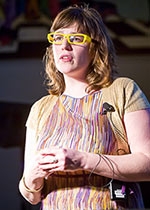 Sarah Schaack
Sarah Schaack
Professor of Biology
Reed College
3203 SE Woodstock Blvd.
Portland, OR 97202
Office: B106
Research Lab: B104
E-mail: schaackmobile@reed.edu
Website: https://sites.google.com/site/schaackwork/
Genetics/genomics, transposable elements, and mutation
My two main interests are 1) the rate, spectrum, and consequences of mutation in nuclear and organellar genomes and 2) the mobilome-- the most dynamic and exciting portion of the genome.
I am interested in the short- and long-term consequences of spontaneous mutation in terms of shaping the size, organization, and landscape of the genome. I am interested in the rate of mutation, and thus its impact on fitness, adaptation, the evolution of sex, and speciation in various environments. This is especially fascinating to me in eukaryotic systems, where gene products from multiple genomes (nuclear and organellar) must be compatible, even though the mutation parameters differ dramatically.
Among the many types of mutation that occur, transposable elements are a source of some of the most dramatic genetic changes that we observe. Mobile DNA (the collective term for selfish genes, jumping genes, transposable elements, mobile genetic elements, mobile introns, and many other types of DNA) can move within and between organisms, and can even cross species boundaries. Further, pieces of mobile DNA can carry normally static DNA (hitchhiking) and can be amplified to high copy number in the genome. Often referred to as "junk DNA", little is known about the impact of mobile DNA other than that it appears to account for a huge proportion of most multicellular eukaryotic genomes.
Despite the importance of spontaneous mutation and the near ubiquity of mobile DNA, we have few empirical estimates of mutation rate and and are only beginning to understand the genomic landscape of eukaryotes. The research in my lab is aimed at understanding the proximate and ultimate changes brought about by mutation, especially those caused by mobile DNA, at the genotypic and phenotypic level.